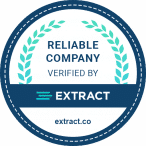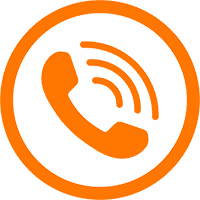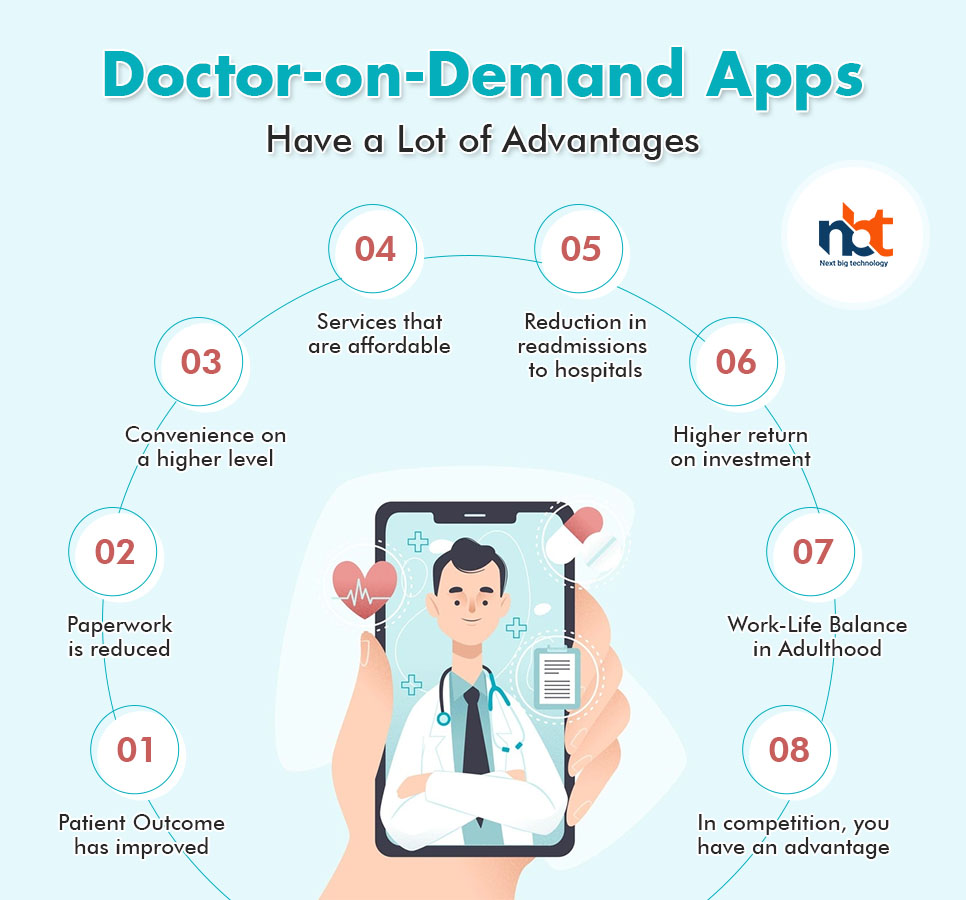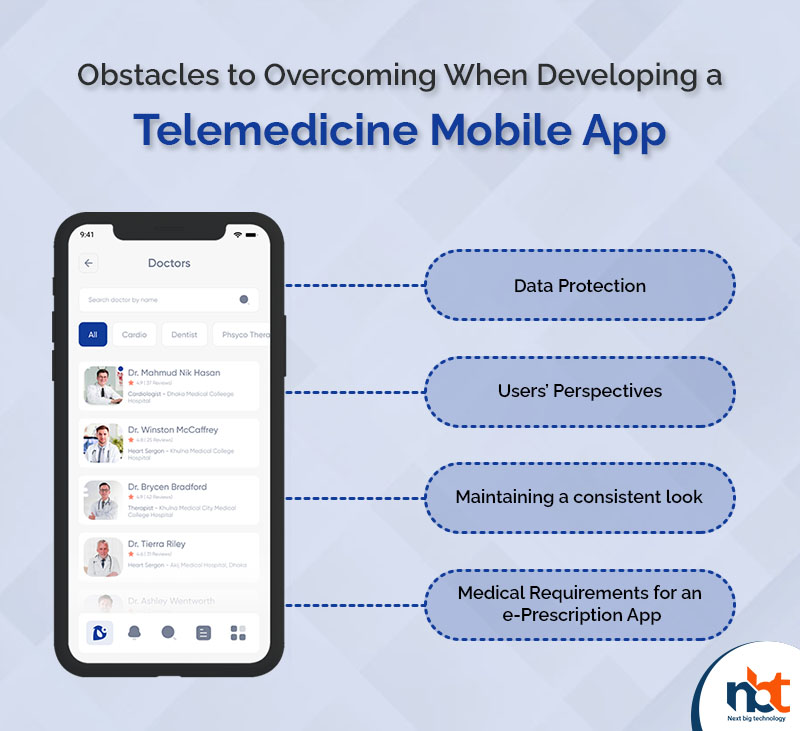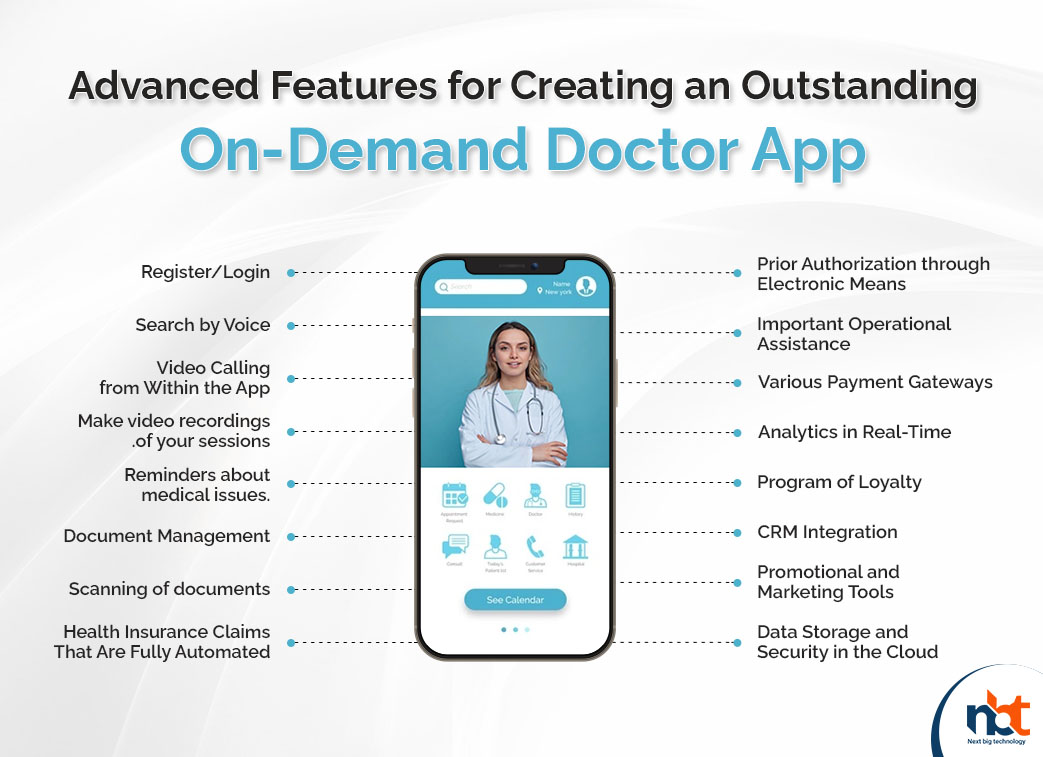Consider the following scenario to better understand the benefits of an on-demand medical mobile app. The situation is that you arrive at your office for an important meeting with all of your work completed, ready to have a fantastic talk with your colleagues and partners, but you suddenly experience a dreadful pain in your head. You’re at a crossroads, deciding whether to go to this meeting for which you’ve worked so hard or to see a doctor about your headache.
In these situations, the decision-making window is incredibly small, and in the surge of adrenaline, you frequently make poor decisions that impact both your health and your job. However, in recent years, an e-prescription or doctor-on-demand app was introduced to help millions of individuals avoid becoming trapped in this situation. These apps have provided an immediate solution to health-related issues. People can use “doctor on-demand” apps to contact doctors online and have a one-on-one chat with the doctor of their choice.
Table of Contents
Doctor-on-Demand Apps Have a Lot of Advantages
Those who choose to participate in these medical apps gain access to a slew of advantages both now and in the future. Let’s take a look at some of the more appealing advantages.
Patient Outcome has improved
Patients might save time by not having to attend clinics and hospitals for follow-ups, missing appointments, obtaining drugs, or repeatedly asking for prescriptions if they used a telemedicine app. This benefits the patient in another manner, in that, unlike when they visit rushed clinics, they receive sufficient attention from their doctors, which improves their whole experience.
Paperwork is reduced
One of the key advantages of telemedicine applications is that they allow healthcare practitioners and patients to keep track of essential information on their mobile devices. This saves both parties a lot of time and effort in terms of keeping track of administrative papers at the office.
Convenience on a higher level
Telemedicine is making a difference in all sections of a city, but it is offering the most help to those in rural areas. People in rural locations, as we all know, suffer the most when it comes to seeing a doctor or medical specialist because practically all doctors live in urban areas. A rural individual will have to drive a long distance to make an appointment, which could be critical in saving the life of a youngster or the elderly.
Services that are affordable
Because these healthcare services are incredibly convenient and available in real-time to the general public, all expenditures related to ER visits and hospital admissions are instantly reduced. These telemedicine solutions have made these processes a lot more manageable.
Reduction in readmissions to hospitals
The main objective of telemedicine apps, as is obvious from all of the preceding statements, is to provide as much support to its patients as possible. Following this, we arrive at a position when patients can benefit from healthcare services while staying at home by using telemedicine apps. To receive all of the benefits, patients do not need to be hospitalized to hospitals.
It has reduced the frequency of hospital readmissions while maintaining the high level of care provided to clients.
Higher return on investment
These telemedicine apps are advantageous to doctors in equal proportion because they allow them to save money on equipment, hospital staff, and infrastructure. This straightforward approach aids doctors in achieving and sustaining a higher return on investment.
Work-Life Balance in Adulthood
It’s remarkable that doctors may engage with their patients via telemedicine apps even when they’re traveling or working from home. These medical apps allow doctors to make virtual visits to their patients’ homes to give necessary medical services. It’s easy to see how this choice can help doctors achieve and maintain a great work-life balance.
In competition, you have an advantage
Not all doctors and medical institutions provide the same level of care to their patients. So, if you want to get ahead of the game, you can invest in telemedicine app development and acquire a competitive advantage in the market.
Because telemedicine apps offer so many advantages, the healthcare and fitness industries are growing at a rapid pace. The fact that this industry was valued at USD 4.50 billion in 2018 and is expected to be worth USD 32.71 billion by 2027, with a CAGR of 24.7 percent during that time period, is proof of this.
Also Read: Looking For Top Doctor Appointment App Development Agency
What Is a Doctor On-Demand App and How Does It Work?
Despite the fact that each telemedicine app has its own working logic, the typical flow of a doctor-on-demand app is as follows:
To receive therapy from a specific doctor, the patient must first log into the system, create an account, and describe his or her symptoms in detail.
The software then goes over the symptoms that the patient has described and finds the most appropriate medical expert nearby based on those symptoms.
After locating a doctor who meets the user’s needs, the patient can video contact the doctor and schedule an appointment through the app’s calendar.
The doctor interacts with the patient about his discomfort in the video consultation that follows. After determining the problem, the doctor prescribes the appropriate treatment, as well as lab testing and other necessary procedures.
After the video consultation is completed, the patient returns to their regular routine and pays the doctor for the obtained healthcare services via a built-in payment portal. He is given invoices with recommended medications and proper doctor’s advice once he pays for his treatment.
Telemedicine or Doctor-on-Demand Apps Market Size and Statistics
The average wait time for a doctor’s appointment in major US cities was found to be 24 days, according to a survey conducted in those locations. One out of every three patients decides to go to the emergency room rather than their preferred physician because of the large delay.
82 percent of patients said that creating technology that makes accessing healthcare benefits as simple as taking a taxi or ordering meals is a good idea.
77 percent of patients prefer to communicate with their doctors via text messaging.
Instead of physical encounters, 69 percent of patients prefer virtual appointments with their doctors.
With all of the advantages that the doctor on-demand app offers, its industry is growing at a quick pace. Its impact can be seen in the fact that the worldwide telehealth industry, which was worth roughly USD 4.50 billion in 2018, is expected to grow at a CAGR of 24.7 percent to USD 32.71 billion by 2027.
From 2015 to 2019, the rate of adoption of digital health tools in the United States has increased.
If you explore around, you’ll find a variety of choices for making money with these health-related apps. In 2018, a survey was done to determine the percentage of monetization tactics used by these healthcare applications:
Obtaining a license (35 percent )
Services such as remote consultation are sold (26 percent )
Third-party application development (25 percent )
Sponsorship is available (24 percent )
High-Quality Content (18 percent )
You must pay for each download (16 percent )
Sales of devices (16 percent )
Advertisements within the app (10 percent )
Buying and selling (8 percent )
Other popular telehealth app monetization strategies include:
1. Belonging
Users commonly pay a monthly or yearly charge to receive a taste of the app using this manner. This model is used by Myca Nutrition.
2. Software-as-a-Service (SaaS)
For private practices, the app must be licensed. Doctor on Demand and American Well are two excellent examples of this strategy. For one employee, American Well charges hospitals roughly $1 per month.
3. Charges for transactions
In this strategy, the app charges its users for their visits on a per-minute basis. selector, a Telenor Group company based in Pakistan, does just that. This service charges $0.08 per minute. The Doctor on Demand, on the other hand, charges patients a 25% consultation fee.
The Show is Being Run by Major On-Demand Doctor Apps
DoctorOnDemand
DoctorOnDemand is a fantastic telemedicine tool that allows consumers to schedule video sessions, receive prescriptions, and communicate with their doctors. This platform is affiliated with around 1400 state-licensed physicians across the United States. Online video appointments, appointment scheduling, Search for a necessary specialist, patient data storage, built-in payment gateway, Some of the most important features of this software are integrated maps for finding nearby pharmacies where you may pick up doctor-prescribed medications.
ZocDoc
ZocDoc is a telemedicine app based in the United States that serves more than 6 million users every month. With the help of an integrated map, you may search for doctors and get reminders about upcoming appointments with ZocDoc.
HealthTap
HealthTap is available for both iOS and Android devices. For virtual doctor appointments, this app’s online version is also available. Payment gateway, secure in-app communications, online video consultation, and other features are all available through HealthTap.
Medici
Medici is a HIPAA-compliant software aimed towards fostering a relationship between doctors and patients. Patients can video, voice, or text chat with doctors, veterinarians, and therapists using the Medici app on their phones. They can also get lab results, medicines, and referrals through this app. On the other hand, a doctor can write prescriptions, set rates, manage schedules, interact with peers, organize group conversations, keep track of all earnings made through the app, set rates, and claim the money.
Marham
In Pakistan, Find a Doctor is the largest healthcare network. Marhampk is a fantastic app that connects thousands of patients with doctors across the country via a variety of venues. The app’s main features include a health forum, appointment booking and scheduling, patient management in-clinic and online audio/video appointments, maps for accurate location, and data from thousands of providers across the country. In addition, Marham now offers a pharmaceutical delivery service that can deliver your medication in as little as a few hours. Android and iOS smartphones can use this software. In addition to the app, Marhampk has a website.
Other Popular Telemedicine/TeleHealth and doctor-on-call Apps
In the United States, the United Kingdom, Europe, and other parts of the world, popular telemedicine apps include Teladoc, Amwell, Doxy.me, Wello, Doctorow, Coviu, Babylon Health, Push Doctor, MinDoktor, Medline, BCBSM Online Visits, and OlaDoc. People utilize these doctor appointment applications to get e-prescriptions and have online doctor consultations.
Obstacles to Overcoming When Developing a Telemedicine Mobile App
Data Protection
Patients who are interested in using these telemedicine apps place a high value on data security. They’ll check to see if the app is safe and secure and if it can protect the information they’ve uploaded.
HIPPA standards, on the other hand, make the work even more difficult because they demand apps to adhere to tight guidelines, which limits software engineers’ innovation. Backend integration will enable your app to have its own server, which will assist you in mediating data between two parties in a HIPAA-compliant manner while also providing much-needed data protection.
Users’ Perspectives
Because the app will have separate components for doctors and patients, the software engineering team confronts an uphill task in developing a fantastic UI/UX implementation. The functionality, user interfaces, and technical capabilities of the two sections will be distinct.
To deliver an excellent user experience, the UX designer must consider the following factors:
Maintaining a consistent look
In both areas of the app, keep an eye on how all of the elements will work together as a unified unit.
Compensation in money.
Many major countries throughout the world have decided to pass telemedicine parity legislation, which is founded on the premise of charging for remote patient treatment by healthcare professionals. If your team is able to add secure card payment, Medicare insurance, modifiers, and various codes into the process of utilizing the app, it makes the process easier for both parties.
Medical Requirements for an e-Prescription App
There are a variety of medical regulations that an e-prescription app must adhere to.
HIPAA (Health Insurance Portability and Accountability Act) applies to health-related apps
HL7 Standards (Health Level 7)
The FDA’s policy on medical apps
Health and Human Services (HHS) guidelines for meaningful use stage 1 and 2 of the HITECH Act
For mobile medical applications, EPSC FDA Policy certification is required.
Overall, an app developer must comply with a variety of compliances, app integrations, and certifications in order to get the app off the ground.
Also Read : Online Doctor Appointment Booking Portal Development Services
Features of an On-Demand Doctor Consultation App in General
Features of Telemedicine Apps for Patients
Sign-In for Users
When a new patient signs up for this app, he must provide information about his chronic illnesses. Aside from that, the patient must supply information on his or her age, gender, and insurance.
Video Medical Consultations
The foundation of a mobile telemedicine app is video calls. Doctors and patients can connect in real-time via video calls. Patients should select HIPAA-compliant telemedicine apps to secure their personal information from data breaches. A third-party API like Daily. co is the greatest option for all consumers in terms of data security.
Look for a Medical Expertise
When a patient has to contact a medical professional for an urgent necessity, he uses geolocation to discover the closest doctor in the area. The software will be consistent with medical laws by integrating the Google Maps platform via a third-party API that calculates the patient’s location and nearby pharmacies.
Doctor’s Reviews
After obtaining treatment from a doctor, the patient has the option of providing comments on that doctor’s performance. He can provide his comments and ratings for the doctor in the reviews and rating section.
Gateway for Payments
The patient must pay the doctor’s costs after receiving a consultation from the doctor. The patient will need a payment gateway to pay through the app, which you will integrate via API.
Features of Telemedicine Apps for Doctors
Panel of Doctors
The doctor panel is an essential component of any telemedicine app since it is linked to electronic health records, which contain vital information about patients, prescription drugs, and a calendar with all booked appointments.
Appointments Management
After completing the first significant step of locating an appropriate medical specialist, the patient must schedule an appointment using the app and enter all pertinent information about his medical issues and documents. After that, the patient’s role is done because the app will automatically handle time slots and notify you when one or more medical specialists are accessible.
Messages in the App
The developer will have to give particular weight to the technical solutions he chooses in order to allow patients and doctors to communicate secure conversations within the app, share x-rays, reports, and prescriptions. All of the information listed above is considered patient-sensitive data, and as such must adhere to telemedicine legislation and norms. As a result, using GDPR and HIPPA-compliant communication platforms like Q-municate is your best bet. This technological solution can be integrated into your app using REST-API and SDK.
Advanced Features for Creating an Outstanding On-Demand Doctor App
Register/Login
Almost all apps now incorporate social network accounts to help users log in, making the process of logging in a lot easier. It is no longer necessary for users to keep track of usernames and passwords.
Search by Voice
Voice search is an advanced function in all doctor on-demand apps that allows users to search for anything on the app without having to type anything. The user can utilize the speaker to search for a doctor or medical assistant, and the search will be done automatically.
Video Calling from Within the App
Because the patient is virtually connected to the doctor via video or audio call, he can openly express his distress. On the other hand, this characteristic aids the doctor in performing their duties properly.
Make video recordings of your sessions.
The doctor’s live video sessions can be recorded and viewed at a later time. If the patient wishes to take a closer look at the medicine or exercises that the doctor recommended, he can do so by watching the recorded session.
Reminders about medical issues.
The patient is reminded of his medication obligations by medical reminders. The software sends a push message with a medication reminder, assisting the patient in taking their prescription on time.
Document Management
Document Management is a term that refers to the process of All of a patient’s documents being kept safe and sound in the app’s locker. The documents aren’t tampered with in any way, and patients can access them whenever they choose.
Scanning of documents
Document sharing has been introduced to the on-demand doctor apps to improve the document sharing experience. It improves the document’s picture and converts it into a sharp, easy-to-read image.
Health Insurance Claims That Are Fully Automated
This function allows the patient to determine whether or not their specified treatments and medications are covered by their insurance. This procedure can be carried out immediately following the creation of the bill.
Prior Authorization through Electronic Means
Electronic Prior Authorisation, or EPA, is an electronic method that allows for the creation of patient- and drug-specific PA criteria, as well as real-time approval for a prescription prior authorization.
Important Operational Assistance
Electronic Medical Record (EMR) (EHR)
Keeping track of all of a patient’s critical records can be a difficult undertaking. Electronic Health Records assist users by storing their medical records online within the app, which may then be provided to them in PDF format as needed.
Various Payment Gateways
In terms of payment alternatives, these apps provide flexibility. Debit cards, credit cards, e-wallet, PayPal, and a variety of additional payment methods are all available.
Also Read: How to Build a Doctor Appointment App Like ZocDoc?
Analytics in Real-Time
This special feature for administrators allows them to keep track of real-time activities such as the number of active patients, doctors, and other vital components of the application.
Program of Loyalty
Customers who have used the app for a specific amount of time and have reached a certain time milestone are eligible for loyalty programs, which include a variety of discounts and offers. As a result of this feature, you’ll have a great rapport with your customers.
CRM Integration
Customer Connection Management (CRM) is a critical component of maintaining a doctor-patient relationship. CRM can be used in a variety of inventive ways to assist administrators in keeping a long-term relationship with their patients.
Promotional and Marketing Tools
Doctors who want to provide extra benefits to their patients, such as discount coupons or enticing offers on their medical bills, might use marketing and promotional techniques.
Data Storage and Security in the Cloud
All of the patients’ medical data and essential information are saved on the cloud storage and can be retrieved at any time. Their medical records and other important paperwork are completely secure.
Before you start developing an e-prescription app, there are a few things you should think about.
1. Uncertainty about remuneration
The US Centers for Medicare and Medicaid Services (CMS) has proposed that Medicare advantage plans provide telemedicine services in light of this risk.
2. Clinics of high quality
Doctors have expressed their concerns about clinic quality, and as a result, several medical institutions have taken significant steps to ensure that clinical quality is up to par in certain locations.
3. Concerns about the quality of care received
During medical visits, medical practitioners must ensure that the quality of care is not compromised.
4. Poor buy-in quality
Some clinicians are skeptical that healthcare visits would eventually replace face-to-face visits, lowering the quality of healthcare services delivered. Avera Health, a regional health organization in South Dakota, is using educational write-ups and in-person talks to overcome doctors’ reluctance to accept telemedicine.
For the Doctor On Demand App, a team structure is required.
The following is the general structure of a team working on an e-prescription app:
Project Manager for Android Developers
Developers of IoS
QA Testers Graphic Designers UX/UI Designers
Developers of backend applications
Doctor On Demand App’s Required Tech Stack
The technology needed to create a telemedicine app is determined by the number of functions it has. However, we’ve put together a minimal software stack for creating an on-demand doctor appointment app.
Java, Swift, Angular, Java, CSS, HTML, and React for front-end development
Android, iOS, and Web Application are the most popular platforms.
Python, Laravel, and Node.js are used for back-end development.
Batch, Twillo, and Push.io are all good options for push notifications, SMS, and in-app messaging.
PayPal API, Stripe API, Braintree SDK, and other e-wallets are used to handle payments.
MongoDB, Cassandra, HBase, and Postgress are among the database options.
Google Cloud, Amazon Web Services, and Microsoft Azure are examples of cloud environments.
MapKit framework for iOS and Google Maps SDK for Android are two options for location monitoring.
BigData, Cisco, Hadoop, Spark, Apache Flink, IBM, and Google Maps API are all good options for real-time tracking.
Also Read : How Doctor Appointment App Is Getting Famous Nowadays?
How Much Does It Cost to Create an App for Scheduling Medical Appointments?
The geographical location of app development, as well as the availability of apps on numerous platforms such as iOS, Android, and Wearables, are all aspects to consider while establishing an e-prescription app.
The location of the app development company.
The location of the mobile app development business you choose has a significant impact on the overall cost of producing an app. The cost of a developer per hour in the United States is between $150 and $250, whereas in Eastern Europe, the cost is between $120-$180, and in Asian countries, the cost is between $40 and $80.
The following features are included.
The number of features that an app will have has a role in determining the overall cost of an e-prescription app. The cost of an MVP (Minimum Viable Product) version of the doctor-on-demand app starts at $30,000 USD. The cost of the software will go to above $80,000 if it is designed for many platforms and includes advanced features.
Conclusion.
The old normal has been replaced by the new normal since the COVID-19 epidemic ravaged the world. There are many new rules in the new normal, but the most important of them all is the delivery of essential necessities to your home. Because people have been advised to stay at home in order to prevent the spread of COVID-19, app developers have a fantastic opportunity to design an app that will bring medical specialists straight to the patient’s door. Developing an app of this kind will connect with all of the patients in desperate need of help at this vital juncture. As a result, the information above will assist you in developing telemedicine software that meets all of the essential needs of medical casualties all over the world.


